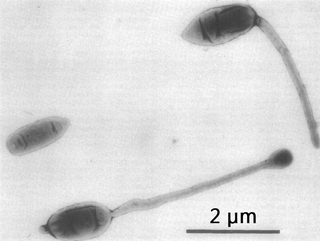Related Research Articles

Pseudomonadota is a major phylum of Gram-negative bacteria. The renaming of several prokaryote phyla in 2021, including Pseudomonadota, remains controversial among microbiologists, many of whom continue to use the earlier name Proteobacteria, of long standing in the literature. The phylum Proteobacteria includes a wide variety of pathogenic genera, such as Escherichia, Salmonella, Vibrio, Yersinia, Legionella, and many others. Others are free-living (non-parasitic) and include many of the bacteria responsible for nitrogen fixation.

The Hyphomicrobiales are an order of Gram-negative Alphaproteobacteria.
The Aurantimonadaceae are a small family of marine bacteria.

The Hyphomicrobiaceae are a family of bacteria. Among others, they include Rhodomicrobium, a genus of purple bacteria.
In taxonomy, Ruegeria is a genus of the Rhodobacteraceae. This genus was formerly known as the marine Agrobacterium before they were reclassified in 1998. It bears in fact the name of Hans-Jürgen Rüger, a German microbiologist, for his contribution to the taxonomy of marine species of Agrobacterium.

Alphaproteobacteria is a class of bacteria in the phylum Pseudomonadota. The Magnetococcales and Mariprofundales are considered basal or sister to the Alphaproteobacteria. The Alphaproteobacteria are highly diverse and possess few commonalities, but nevertheless share a common ancestor. Like all Proteobacteria, its members are gram-negative and some of its intracellular parasitic members lack peptidoglycan and are consequently gram variable.
Devosia is a genus of Gram-negative soil bacteria. It is named after the Belgian microbiologist Paul De Vos. They are motile by flagella, the cells are rod-shaped.
Maricaulis is a genus of the Maricaulaceae.
Afifella is a genus in the phylum Pseudomonadota (Bacteria). Afifella are found in marine and estuarine settings, including microbial mats. They are anaerobes, with one cultured representative capable of photosynthesis.
The Magnetococcales were an order of Alphaproteobacteria, but now the mitochondria are considered as sister to the alphaproteobactera, together forming the sister the marineproteo1 group, together forming the sister to Magnetococcidae.
Pseudoxanthobacter is a genus of Gram-negative, rod-shaped, aerobic and nitrogen-fixing bacteria from the family Pseudoxanthobacteraceae.
Erythrobacteraceae is a bacterium family in the order of Sphingomonadales.
The Coriobacteriia are a class of Gram-positive bacteria within the Actinomycetota phylum. Species within this group are nonsporulating, strict or facultative anaerobes that are capable of thriving in a diverse set of ecological niches. Gordonibacter species are the only members capable of motility by means of flagella within the class. Several species within the Coriobacteriia class have been implicated with human diseases that range in severity. Atopobium, Olsenella, and Cryptobacterium species have responsible for human oral infections including periodontitis, halitosis, and other endodontic infections. Eggerthella species have been associated with severe blood bacteraemia and ulcerative colitis.
Stappiaceae is a family of Alphaproteobacteria.
Tepidamorphaceae is a family of Alphaproteobacteria.
Amorphaceae is a family of Alphaproteobacteria.
Methylorubrum is a genus of bacteria from the family Methylobacteriaceae.
Emcibacteraceae is a family of bacteria.
The Temperatibacteraceae are a family of bacteria.
Reyranella is a genus of bacteria from the order Rhodospirillales.
References
- ↑ Hördt A, García López M, Meier-Kolthoff JP, Schleuning M, Weinhold LM, Tindall BJ, Gronow A, Kyrpides NC, Woyke T, Göker M (2020). "Analysis of 1,000+ Type-Strain Genomes Substantially Improves Taxonomic Classification of Alphaproteobacteria". Front. Microbiol. 11: 468. doi: 10.3389/fmicb.2020.00468 . PMC 7179689 . PMID 32373076.
- ↑ Euzéby JP, Parte AC. "Kaistiaceae". List of Prokaryotic names with Standing in Nomenclature (LPSN). Retrieved May 15, 2021.
- ↑ Yee B, Oertli GE, Fuerst JA, Staley JT (2010). "Reclassification of the polyphyletic genus Prosthecomicrobium to form two novel genera, Vasilyevaea gen. nov. and Bauldia gen. nov. with four new combinations: Vasilyevaea enhydra comb. nov., Vasilyevaea mishustinii comb. nov., Bauldia consociata comb. nov. and Bauldia litoralis comb. nov". Int. J. Syst. Evol. Microbiol. 60 (Pt 12): 2960–2966. doi:10.1099/ijs.0.018234-0. PMC 3052453 . PMID 20118292.
- ↑ Yarza P, Yilmaz P, Pruesse E, Glöckner FO, Ludwig W, Schleifer KH, Whitman WB, Euzéby J, Amann R, Rosselló-Móra R (2014). "Uniting the classification of cultured and uncultured bacteria and archaea using 16S rRNA gene sequences". Nat Rev Microbiol. 12 (9): 635–45. doi:10.1038/nrmicro3330. hdl:10261/123763. PMID 25118885. S2CID 21895693.